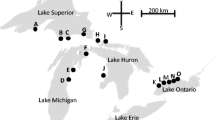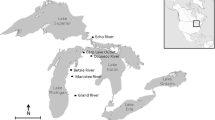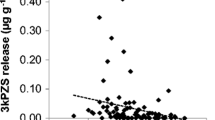Abstract
Spermiating male sea lamprey (Petromyzon marinus) release a sex pheromone, of which a component, 7α, 12α, 24-trihydoxy-3-one-5α-cholan-24-sulfate (3kPZS), has been identified and shown to induce long distance preference responses in ovulated females. However, other pheromone components exist, and when 3kPZS alone was used to control invasive sea lamprey populations in the Laurentian Great Lakes, trap catch increase was significant, but gains were generally marginal. We hypothesized that free-ranging sea lamprey populations discriminate between a partial and complete pheromone while migrating to spawning grounds and searching for mates at spawning grounds. As a means to test our hypothesis, and to test two possible uses of sex pheromones for sea lamprey control, we asked whether the full sex pheromone mixture released by males (spermiating male washings; SMW) is more effective than 3kPZS in capturing animals in traditional traps (1) en route to spawning grounds and (2) at spawning grounds. At locations where traps target sea lampreys en route to spawning grounds, SMW-baited traps captured significantly more sea lampreys than paired 3kPZS-baited traps (~10 % increase). At spawning grounds, no difference in trap catch was observed between 3kPZS and SMW-baited traps. The lack of an observed difference at spawning grounds may be attributed to increased pheromone competition and possible involvement of other sensory modalities to locate mates. Because fishes often rely on multiple and sometimes redundant sensory modalities for critical life history events, the addition of sex pheromones to traditionally used traps is not likely to work in all circumstances. In the case of the sea lamprey, sex pheromone application may increase catch when applied to specifically designed traps deployed in streams with low adult density and limited spawning habitat.
Similar content being viewed by others
References
Adair R, Sullivan P (2013) Sea lamprey control in the Great Lakes 2012. Great Lakes Fishery Commission Annual Report. Ann Arbor, MI
Applegate VC (1950) Natural history of sea lamprey (Petromyzon marinus) in Michigan. U.S. Fish Wild Serv Spec Sci Rep Fish Serv 55
Barbosa M, Magurran AE (2006) Female mating decisions: maximizing fitness? J Fish Biol 68:1636–1661
Bellas TE, Bartell RJ, Hill ADA (1983) Identification of two components of the sex pheromone of the moth, Epiphyas postvittana (lepidoptera, tortricidae). J Chem Ecol 9:503–512
Binder TR, McDonald DG (2008) The role of temperature in controlling diel activity in upstream migrant sea lampreys (Petromyzon marinus). Can J Fish Aquat Sci 65:1113–1121
Bravener GA, McLaughlin RL (2013) A behavioral framework for trapping success and its application to invasive sea lamprey. Can J Fish Aquat Sci 70:1438–1466
Candolin U (2003) The use of multiple cues in mate choice. Biol Rev 78:575–595
Christie GC, Goddard CI (2003) Sea lamprey International Symposium (SLIS II): advances in the integrated management of sea lamprey in the Great Lakes. J Great Lakes Res 29(Suppl 1):1–14
Chung-Davidson YW, Bryan MB, Teeter J, Bedore CN, Li W (2008) Neuroendocrine and behavioral responses to weak electric fields in adult sea lampreys (Petromyzon marinus). Horm Behav 54:34–40
Chung-Davidson Y-W, Priess MC, Yeh C-Y, Brant CO, Johnson NS, Li K, Nanlohy KG, Bryan MB, Brown T, Choi J, Li W (2013) A thermogenic secondary sexual character in male sea lamprey. J Exp Biol 216:2702–2712
Dickens JC, Jang EB, Light DM, Alford AR (1990) Enhancement of insect pheromone responses by green leaf volatiles. Naturwissenschaften 77:29–31
Dulka JG, Stacey NE, Sorensen PW, Vanderkraak GJ (1987) A steroid sex-pheromone synchronizes male–female spawning readiness in goldfish. Nature 325:251–253
Hasler AD, Scholz AT (1983) Olfactory imprinting and homing in salmon. Springer, Berlin
Hwang SY, Lindroth RL (1997) Clonal variation in foliar chemistry of Aspen: effects on gypsy moths and forest tent caterpillars. Oecologia 111:99–108
Irvine IAS, Sorensen PW (1993) Acute olfactory sensitivity of wild common carp, Cyprinus carpio, to goldfish hormonal sex pheromones is influenced by gonadal maturity. Can J Zool 71:2199–2210
Johnson NS, Yun S-S, Thompson HT, Brant CB, Li W (2009) A synthesized pheromone induces upstream movement in female sea lampreys and summons them into traps. Proc Natl Acad Sci U S A 106:1021–1026
Johnson NS, Yun S-S, Buchinger TJ, Li W (2012) Multiple functions of multi-component mating pheromone in sea lamprey (petromyzon marinus). J Fish Biol 80:538–554
Johnson NS, Siefkes MJ, Wagner CM, Dawson H, Wang H, Steeves T, Twohey M, Li W (2013) A synthesized mating pheromone component increases adult sea lamprey (petromyzon marinus) trap capture in management scenarios. Can J Fish Aquat Sci 70:1101–1108
Kleerekoper H (1969) Olfaction in fishes. Indiana University Press, Bloomington
Li W, Scott AP, Siefkes MJ, Yan HG, Liu Q, Yun S-S, Gage DA (2002) Bile acid secreted by male sea lamprey that acts as a sex pheromone. Science 296:138–141
Li W, Twohey M, Jones M, Wagner M (2007) Research to guide use of pheromones to control sea lamprey. J Great Lakes Res 33(Special Issue 2):70–86
Li K, Brant CO, Siefkes MJ, Kruckman HG, Li W (2013) Characterization of a novel bile alcohol sulfate released by sexually mature male sea lamprey (Petromyzon marinus). Plos One 8:e68157
Löfstedt C, Van Der Pers JNC, Löfqvist J, Lanne BS, Appelgren M, Bergström G, Thelin B (1982) Sex Pheromone components of the turnip moth Agrotis segetum: chemical identification, electrophysiological evaluation and behavioral activity. J Chem Ecol 8:1305–1321
Luehring MA, Wagner CM, Li W (2011) The efficacy of two synthesized sea lamprey sex pheromone components as a trap lure when placed in direct competition with natural male odors. Biol Invasions 13:1589–1597
Madsen HF, Vakenti JM (1972) Codling moths: female-baited and Synthetic pheromone traps as population indicators. Environ Entomol 1:554–557
Mathis A, Smith RJF (1992) Avoidance of areas marked with a chemical alarm substance by fathead minnows (Pimephales promelas) in a natural habitat. Can J Zool 70:1473–1476
McLennan DA (2003) The importance of olfactory signals in the gasterosteid mating system: sticklebacks go multimodal. Biol J Linn Soc 80:555–572
Mitchell ER, Agee HR, Heath RR (1989) Influence of pheromone trap color and design on capture of male velvetbean caterpillar and fall armyworm moths (lepidoptera: noctuidae). J Chem Ecol 15:1775–1784
Mullett KM, Heinrich JW, Adams JV, Young RJ, Henson MP, McDonald RB, Fodale MF (2003) Estimating lake-wide abundance of spawning-phase sea lampreys (petromyzon marinus) in the Great Lakes: extrapolating from sampled streams using regression models. J Great Lakes Res 29(suppl 1):240–252
Murphy CA, Stacey NE, Corkum LD (2001) Putative steroidal pheromones in the round goby, Neogobius melanostomus: olfactory and behavioral responses. J Chem Ecol 27:443–470
Neff BD (2003) Decisions about parental care in response to perceived paternity. Nature 422:716–719
Poling KR, Fraser EJ, Sorensen PW (2001) The three steroidal components of the goldfish preovulatory pheromone signal evoke different behaviors in males. Comp Biochem Physiol B 129:645–651
Real L (1990) Search theory and mate choice. I. Models of single-sex discrimination. Am Nat 136:376–405
Siefkes MJ, Winterstein SR, Li W (2005) Evidence that 3-keto petromyzonol sulphate specifically attracts ovulating female sea lamprey, (Petromyzon marinus). Anim Behav 70:1037–1045
Smith BR, Tibbles JJ (1980) Sea lamprey (petromyzon marinus) in Lakes Huron, Michigan, and Superior: history of invasion and control, 1936–78. Can J Fish Aquat Sci 37:1780–1801
Sorensen PW, Stacey NE (2004) Brief review of fish pheromones and discussion of their possible uses in the control of non-indigenous teleost fishes. N Z J Mar Freshw Res 38:399–417
Sorensen PW, Pinillos M, Scott AP (2005) Sexually mature male goldfish release large quantities of androstenedione into the water where it functions as a pheromone. Gen Comp Endocrinol 140:164–175
Tumlinson JH, Hendricks DE, Mitchell ER, Doolittle RE, Brennan MM (1975) Isolation, identification, and synthesis of the sex pheromone of the tobacco budworm. J Chem Ecol 1:203–214
Twohey MB, Sorensen PW, Li W (2003) Possible applications of pheromones in an integrated sea lamprey management program. J Great Lakes Res 29:794–800
Vetter RS, Baker TC (1984) Behavioral responses of male Heliothis zea moths in sustained-flight tunnel to combinations of 4 compounds identified from female sex pheromone gland. J Chem Ecol 10:193–202
von Frisch K (1938) Zur Psychologie des Fischschwarmes. Naturwissenschaften 26:601–606
Wagenmakers EJ, Farrell S (2004) AIC model selection using Akaike weights. Psychon Bull Rev 11:192–196
Wagner CM, Thomas AF (2010) A full-scale field test of the efficacy of the male mating pheromone compound 3-keto-petromyzonal-sulfate in trapping-for-control scenarios. Great Lakes Fishery Commission Project Completion Report. Mich, Ann Arbor
Xi X, Johnson NS, Brant CO, Yun S-S, Chambers KL, Jones AD, Li W (2011) Quantification of a male sea lamprey pheromone in tributaries of the Laurentian Great Lakes by liquid chromatography-tandem mass spectrometry. Environ Sci Technol 45:6437–6443
Young JR (2005) Integrating heterogenous survey data to characterize the success of the Lake Huron sea lamprey (Petromyzon marinus) control program. Dissertation, Michigan State University
Yun SS, Scott AP, Li W (2003) Pheromones of the male sea lamprey, Petromyzon marinus L.: structural studies on a new compound, 3-keto allocholic acid, and 3-keto petromyzonol sulfate. Steroids 68:297–304
Yun S-S, Wildbill AJ, Siefkes MJ, Moser ML, Dittman AH, Corbett SC, Li W, Close DA (2011) Identification of putative migratory pheromones from Pacific lamprey (Lampetra tridentate). Can J Fish Aquat Sci 68:2194–2203
Acknowledgments
The Great Lakes Fishery Commission funded this project. U.S. Fish and Wildlife provided barrier-integrated traps at Miners and Rock rivers. Field assistance was provided by Katherine Borowicz, Linnea Brege, Hugh McMath, Hayley O’Meara, Trevor O’Meara, and Melissa Pomranke. Dr. Justin VanDehey provided comments on an early draft of this manuscript. The use of sea lamprey was approved by Michigan State University Institutional Animal Use and Care Committee and followed the guidelines of the U.S. Geological Survey and U.S. Fish and Wildlife Service. This manuscript is contribution 1,909 of the U.S. Geological Survey Great Lakes Science Center. Any use of trade, product, or firm names is for descriptive purposes only and does not imply endorsement by the U.S. Government.
Author information
Authors and Affiliations
Corresponding author
Electronic supplementary material
Below is the link to the electronic supplementary material.
ESM 1
(DOCX 117 kb)
Rights and permissions
About this article
Cite this article
Johnson, N.S., Tix, J.A., Hlina, B.L. et al. A Sea Lamprey (Petromyzon marinus) Sex Pheromone Mixture Increases Trap Catch Relative to a Single Synthesized Component in Specific Environments. J Chem Ecol 41, 311–321 (2015). https://doi.org/10.1007/s10886-015-0561-2
Received:
Revised:
Accepted:
Published:
Issue Date:
DOI: https://doi.org/10.1007/s10886-015-0561-2




